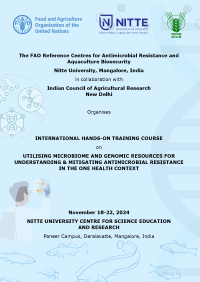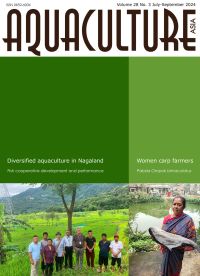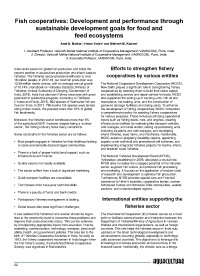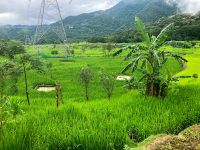With the implementation of the new aquatic animal disease reporting in the Asia Pacific region from January 2021, and in lieu of the published QAAD Reports (last issue published was 4th quarter of 2020), NACA is publishing reported aquatic animal diseases submitted by countries in the Asia-Pacific region. This report covers the first quarter of 2024 and the original and updated reports can be accessed from the QAAD page.
Nitte University is hosting a five-day international training course focused on utilising microbiome and genomic resources to understand and mitigate antimicrobial resistance (AMR) in a One Health context. This course aims to build capacity among professionals from low and middle-income countries in managing AMR, a critical global health issue impacting humans, animals, and the environment.
The course is organised by the FAO Reference Centres for Antimicrobial Resistance and Aquaculture Biosecurity and Nitte University, in collaboration with the Indian council of Agricultural Research and FAO. Registration is free but participants must meet their own travel and subsistence costs.
In this issue:
- Progressive women carp farmers of Haldia, Purba Medinipur, West Bengal, India.
- Captive breeding of Ompok bimaculatus (pabda): An indigenous catfish of North East India.
- Reaching out to the unreached through diversified aquaculture in Nagaland.
- Fish cooperatives: Development and performance through sustainable development goals for food and feed ecosystems.
- NACA Newsletter.
The objective of this study was to examine the inception and development of various schemes for fishery cooperatives during the NITI Aayog period (2015-2023) in India. The study aims to investigate the capacity building requirements of fisher cooperative societies and the challenges faced by fishery cooperatives in India. By conducting training needs assessments, enhancing capacity, strengthening businesses, and leveraging government schemes, the study seeks to advance the long-term objectives of the Sustainable Development Goals (SDG) related to poverty reduction, food security, equality, and institutional development. This initiative will bolster a resilient framework for food security and protein enrichment aligned with SDG targets, thereby fostering stakeholder prosperity within the fish cooperative ecosystem and addressing policy imperatives for sustainable development.
Nagaland is one of the eight sister states in northeast India. It is a mountainous region, home to diverse indigenous tribes with distinct cultures. With a population of 2.28 million, the total potential area for aquaculture is estimated to be around 30,000 hectares, but around 90% of this area remains untapped. The ICAR-Central Institute of Freshwater Aquaculture (CIFA) has made significant efforts to establish aquaculture as a viable livelihood option for the people of Nagaland through programmes on i) paddy and amur carp farming, and ii) promotion of ornamental fish farming among school children. This article describes efforts to implement a project on amur carp farming as a diversified aquaculture practice under the Northeast Program. Further efforts to initiate aquarium-based farming of ornamental fish species through a capacity building programme and distribution of aquariums and ornamental fish species to high schools are also described.



